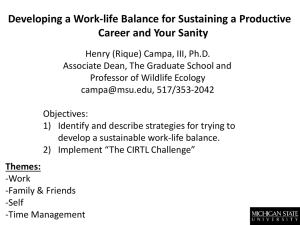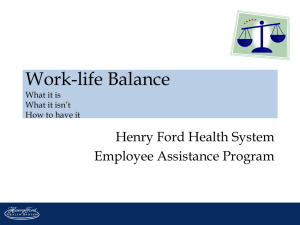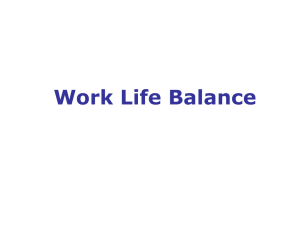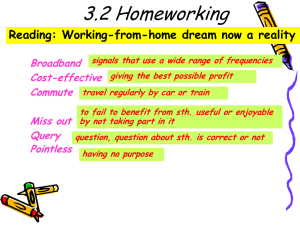Dias nummer 1
advertisement
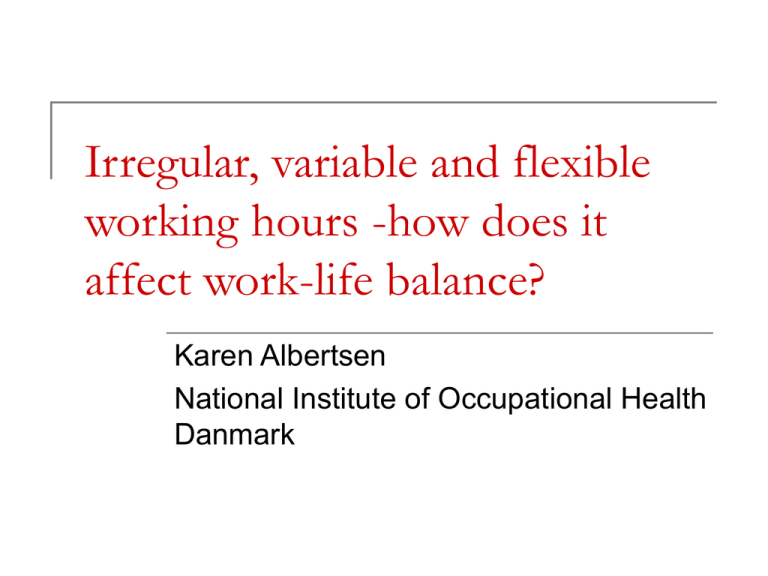
Irregular, variable and flexible working hours -how does it affect work-life balance? Karen Albertsen National Institute of Occupational Health Danmark Topics: How many and who experience work-life conflicts? How does working hours, working overtime and irregular working hours affect work-life balance? Is flexibility the solution? Working hours and work-life balance A representative Danish study, COpenhagen PSychoSOcial Questionnaire (COPSOQ),20042005, 3517 participants at work, NIOH, DK Results and examples from a literature review, Collaboration project financed by The Nordic Council of Ministries An example of an intervention in working time arrangements in a psychiatric ward, Women at work, Multiple case intervention study (17 interventions),2000 – 2004, NIOH,DK How many and who experience work-life conflicts in Denmark and EU? Work-life conflicts in selected EUcountries 30 25 20 15 10 5 ia La tv ia on E st u. .. Li th en Sw ed an d Fi nl en ... D Au st ria 0 Sourse: ”Quality of life in Europe”, 2003, European Foundation 1/4-1/3 experience time- and energy conflicts from work to private life in DK 40 35 30 25 Men women 20 15 10 5 0 Time conflicts Energy conflicts COPSOQ 2005; NIOH,DK Few experience time- and energy conflicts from private life to work 4,5 4 3,5 3 2,5 Men women 2 1,5 1 0,5 0 Time conflicts Energy conflicts COPSOQ 2005; NIOH,DK ysi c ian l se rv i c lic rs riv ers ub ane ork er sd ,p ew Bu ark s d Su p s Nu r se sa erv nd s iso den rs a Pro tist nd ff. s exe Hu cut ma ive ni t s ya nd Ma soc na ial ger sp riv Sch ate ool tea che rs Ph Po sta Cle kil le Cle ter s, s Fit Work-life conflicts in selected job groups (among 56): 45 40 35 30 25 20 15 10 Scale score (0-100) 5 0 Results available on www.ami.dk Summary 1/4 - 1/3 of the working population experience conflicts from work to private life in Denmark More people experience problems in the “new” EU member states Few people experience problems from private life to work More people experience energy than time problems No large gender differences Primarily people with higher education and school teachers People in “Work without boundaries” How does working hours, working overtime and irregular working hours affect work-life balance? Long working hours and overtime work damage work-life balance: Strong scientific evidence that a high number of working hours are associated with less balance between work and private life (15/20) Pattern more consistent among women (8/8) than men (1/5) Strong scientific evidence that overtime work are associated with lower levels of work life balance (6/6) Overtime work problematic for both full- and part time employed Fit of working hours, rewards and compensation for overtime work important mediators OR for work- home interference higher under low reward conditions 3,5 3 2,5 2 1,5 1 0,5 0 No overtime/ high rewards No overtime/ low rewards Overtime/ high rewards Owertime/ low rewards Van der Hulst & Geurts, 2001 OR for work-home interference when working overtime is much higher under low reward and high pressure conditions 8 7 6 5 4 3 2 1 0 e sure sure sure ssur s s s e e e e r r r r p p p p igh low ig h low h h / / s / / s s d s d rd d ar war war r ew ewa e r e r r w h h Lo Low Hig Hig Van der Hulst & Geurts, 2001 Irregular working hours damage work-life balance Strong scientific evidence, that shift work is associated with poor work-life balance (6/6) Shift work prospectively related to higher work-home interference (Jansen et al., 2003) Backward rotating shifts worse than forward rotating (Van Amelsvoort, 2004) Negative effects of shift work on children and marital quality Poorer cognitive stimulation of children (Heymann & Earle 2001) Higher odds for young children of behavioral and emotional difficulties (Strazdin et al., 2004) Marital instability (Presser, 2000) Prospectively associated with marital problems and divorce (White & Keith, 1990) Shift work increase marital instability Shift-work cross sectional associated with: Prospectively: lower marital happiness higher sexual problems child related problems. Disagreements increased when one of the spouses started to work shifts Interaction increased and child-related problems decreased when one of the spouses dropped shift work The probability of divorce increaded by 57% for people working in shifts (after adjustment for other factors) White & Keith, 1990 Summary Adverse effects of long working hours, overtime work and irregular hours on WLB Adverse effects of irregular hours on children's wellbeing and marital quality Moderating effects of fit, reward and pressure on overtime work Few prospective studies Few studies with family or couple as entity Few studies of effects on children Conceptual problems: What are we measuring? Is flexibility the solution? - Or part of the problem? Example: A working time intervention within a psychiatric hospital In collaboration with: Joanna Pryce & Karina Nielsen Organization of intervention Aim: Improve work-life balance Focus: work schedule Steering committee with representatives from teams, security representatives, representatives from trade union and project manager Daily planning and coordination handled by the project manager Two external consultants associated the project in the whole period Participants: 4 nursing teams in intervention group (n= 86) 5 nursing teams in comparison group (n=91) 60% nurses 40% health care assistants 92% female Average age 43 The intervention Participatory approach 3 out of 4 teams chose an empty roster intervention Employees should fill in own schedule under responsibility of the needs of others Fine – tuning of roster by two nurses on a rotating basis Results only includes the three teams implementing the empty roster Effect- and process evaluation Process evaluation: Interviews with project managers, line managers, employees, consultants Focus group interviews Questions to process in questionnaires Baseline questionnaire Workshop Baseline questionnaire 20 month follow up Implementation of interventions Process evaluation: Focus group interviews Questions to process in questionnaires Comparison groups 20 month follow up Satisfaction with work-life balance improved 3,4 3,3 3,2 Time 1 Time 2 3,1 3 2,9 2,8 Comparison Intervention Job satisfaction and community improved 90 80 70 60 50 Time 1 Time 2 40 30 20 10 0 Satisfaction Satisfaction Community Community Comparison Intervention Comparison Intervention Social support improved 74 73 72 Time 1 Time 2 71 70 69 68 comparison Intervention From process evaluation Managers: Employees gained better insight in available resources and utilization of resources Employees: Initial resistance to the intervention Positively received - entry into a broader discussion about the way in which work is designed and managed. Competition to be the first one to fill in the schedule Insecurity related to increased responsibility for the finetuning of the plan Summary: Intervention improved job-satisfaction, work-life balance, social support and feelings of community No effect on health and stress variables Relative simple and cheap intervention Important that new responsibilities are followed by new qualifications Scientific evidence for the positive effect of control over working hours Strong scientific support that control over working hours is associated with better work-life balance (10/12) No evidence that control moderate or mediate the effect of long or irregular hours (3/3) Control can not compensate for high number of hours or irregular hours Problem in many studies: lack of control of relevant work environmental factors Control often associated with a good work environment in general No effect of flexible work hours in a large, prospective and adequately controlled study WFC was predicted over 1 year among 5143 men by: High psychological, emotional and physical demands Low decision latitude Low social support Conflicts with supervisor Job insecurity Shift work – but not flexible work hours, overtime work or commuting time WFC was predicted over 1 year among 999 women by: Physical demands Overtime work Commuting time – but not flexible work hours Jansen et al., 2003 Summary Positive effects of influence on WLB and wellbeing No moderating or mediating effects of influence Other work environmental factors may be more important Perspectives/questions Influence over working hours improve worklife balance - BUT Job groups with high influence over work schedule have low work life balance It may be that a certain level of influence over working hours are important, but that no regulation give rise to new problems Self-regulation in a labor market with the goal of constantly increasing efficiency can be dangerous! Dick Birds tries with catering: ”That's it! Now, your employees can have lunch, including salad, chicken, and all coffee consumed during the day, through this drip. All breaks are gone! They will just work uninterrupted! And you pay me! All are happy!” Thank you for your attention!
